Sister Lillian Murphy Community
The award-winning housing design of the Sister Lillian Murphy Community in San Francisco exceeds its equitable and affordable housing goals while significantly contributing to the overall transformation of the neighborhood.

Project highlights: Sister Lillian Murphy Community
- Architect: Paulett Taggart Architects
- Associate Architect: StudioVARA
- Owner: Mercy Housing California
- Location: San Francisco
- Category: Excellence in Affordable Housing
- Project site: Brownfield
- Building program type(s): Residential - multi-family, 5 or more units
Shaped by community concerns about the large mixed-use and industrial buildings that characterize the Mission Bay redevelopment area in San Francisco, this project cracks the perimeter block typology into four articulated wings. The building exceeds the clients’ goals of offering equitable and affordable housing for the city’s disadvantaged families while also contributing significantly to the overall transformation of the neighborhood.
At just over 300 acres, Mission Bay was once marked by rail yards and industrial buildings that were built on top of a landfill. Its redevelopment, which began in the 1990s, incorporates a mix of market-rate and affordable housing, business and employment opportunities, and enhanced infrastructure. The nonprofit client for this project was an early supporter of Mission Bay’s transformation, opening the neighborhood’s first affordable housing project for low-income seniors there.
This new addition to the neighborhood, named after a champion and developer of affordable housing, offers 152 homes, from studio apartments to five-bedroom units, for households that annually earn up to 80% of the area median income. Its easily identified wings are connected by open-air circulation and multilevel landscapes that offer residents visual connections to the surrounding neighborhood while maximizing daylight in outdoor areas.
Input from the community also shaped the program placement and the design of each wing’s facade to reflect those area’s contexts. The building’s main entry and ground-floor child development center face Mission Bay Kids Park. The building’s south entry fronts Mission Bay Commons, viewed as the neighborhood’s “backyard” park, and contains a children’s music school, courtyard, and community room. The final wing is lower in height to respect the scale and intimacy of a mid-block pedestrian passage.
The project’s interiors are open and airy, warmed by the wood elements throughout. A corner stair tower at the main entry is a new beacon for the neighborhood with a dynamic pattern of light shaped by its unique window configuration. It provides sweeping views for residents, encouraging them to use the stairs as part of an active and healthy lifestyle.
Outdoor spaces on the ground floor and the upper-level courtyards work in concert with other vignettes as an extension of the indoor common areas. They all boast a range of seating options and vibrant landscaping. The perforated patterns of the bicycle pavilion, an additional enticement for healthy living, casts playful shadows in the sunlight and glows as a lantern in the evening. These spaces and the building’s outdoor circulation offer ample fresh air, a critical consideration that was spotlighted by the COVID-19 pandemic.
Framework for Design Excellence measures
Was there a design charrette? No
Site area that supported vegetation (landscape or green roof) pre-development: Unknown
Site area that supports vegetation post-development: 20%
Site area covered by native plants supporting native or migratory species and pollinators: 20%
Strategies used to promote Design for Ecosystems: Biodiversity, Dark skies, Bird safety, Soil conservation, Habitat conservation, flora/fauna, Abatement of specific regional environmental concerns
Is potable water used for irrigation? Yes
Is potable water used for cooling? No
Is rainwater collected on-site? No
Stormwater managed on-site: 100%
2030 Commitment baseline EUI: 78kBtu/sf/yr
Predicted net EUI including on-site renewables: 30kBtu/sf/yr
Reduction from the benchmark: 38%
Is the project all-electric? No
Level of air filters installed: Yes
Was a “chemicals of concern” list used to inform material selection? Yes
Do greater than 90% of occupied spaces have a direct view to the outdoors? Unknown
Were embodied carbon emissions estimated for this project? No
Embodied carbon emissions, including the extraction and manufacturing of materials used in construction: 3989 kgCO2e/m2/yr
Estimated service life: 50
Floor area, if any, representing adapting existing buildings: 0%
Ability to survive without utility power: Passive survivability
Which of the following risk assessment and resilience services were provided? Building vulnerability assessment
Has a post-occupancy evaluation been conducted? No, but a POE will be conducted
Building performance transparency steps taken: Present the design, outcomes, and/or lessons learned to the office
Project team & Jury
Year of substantial project completion: 2021
Gross conditioned floor area: 151571 sq. ft.
Prime Architect/Architect of Record: Paulett Taggart Architects Paulett Taggart, Principal Roselie Enriquez Ledda, Associate Principal Karl Vinge, Associate Melissa Steenport Jacob Kackley Mojdeh Kasraie Hanna Sul Matthew Ridgeway Elise Riley
Associate Architect: StudioVARA Christopher Roach, Principal Jacquelyn Fung, Studio Director Nick Brown, Associate
Landscape Architect: GLS Landscape | Architecture, Gary Strang, Principal
Civil Engineer: Luk & Associates Jackie Luk, Principal
Structural Engineer: KPFF Greg Wagner, Principal=
Mechanical/Electrical/Plumbing: Emerald City Engineers John Toman, President
Dry Utilities/Joint Trench: Urban Design Consulting Engineers Jason Ling, Principal
Green Consultant & Energy Modeling: Bright Green Strategies Sharon Block, Director of Sustainability
Lighting Design: Auerbach Glasow Patricia Glasow, Executive Vice President
Acoustic Consultant: Charles M. Salter Associates, Inc. Alex Salter, Vice President
General Contractor: Cahill Contractors Arash Baradaran, Vice President
Catherine Baker, FAIA, Chair, Nowhere Collaborative, Chicago
John DeForest, AIA, DeForest Architects, Seattle
Brian Lane, FAIA, Koning Eizenberg, Santa Monica, Calif.
Amit Price Patel, AIA, DIALOG, Vancouver, British Columbia
Michael D. Robinson, AIA, Robi4 Architecture & Planning, San Diego
The Housing Award emphasizes good housing as a necessity of life, a sanctuary for the human spirit, and a valuable national resource. Recipients show the world how beauty, safety, sustainability, and comfort can come together.
Ten projects showcase the best in housing design.













